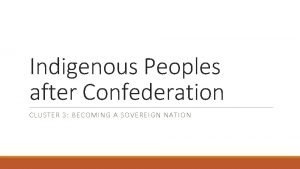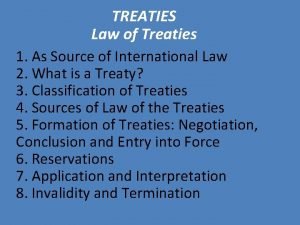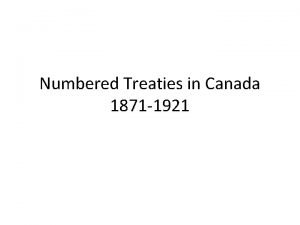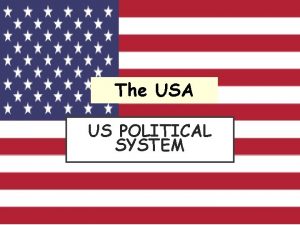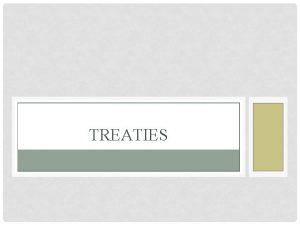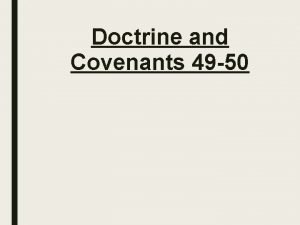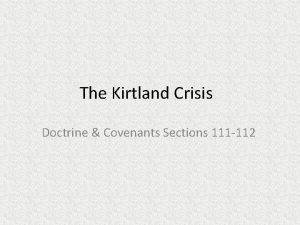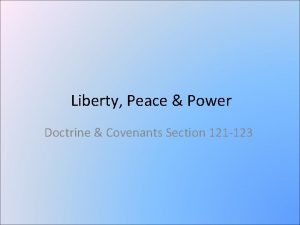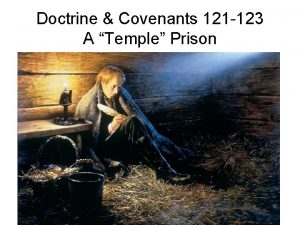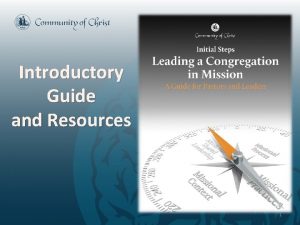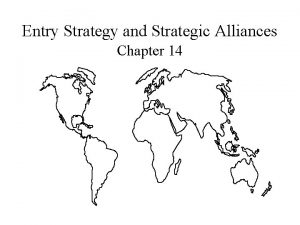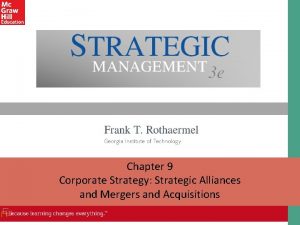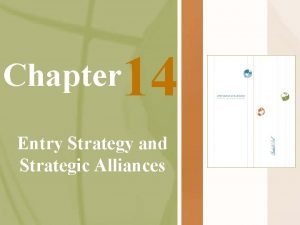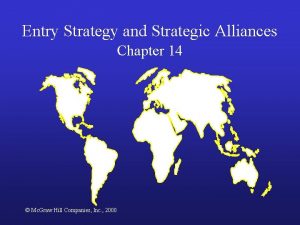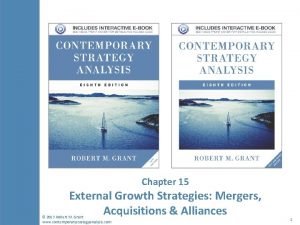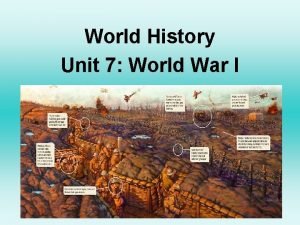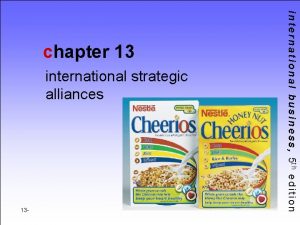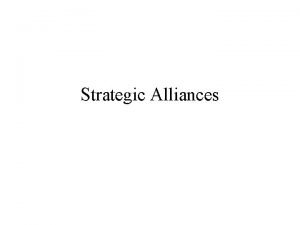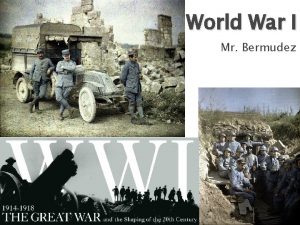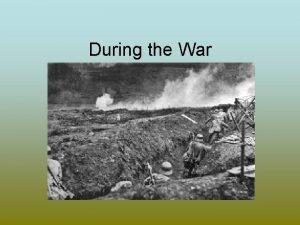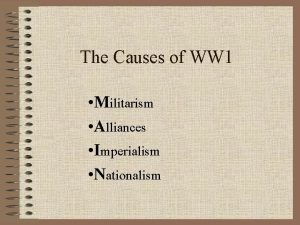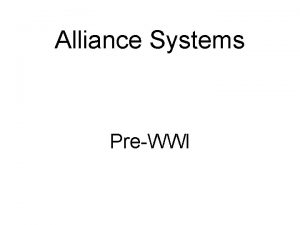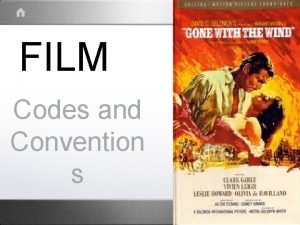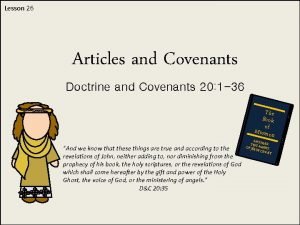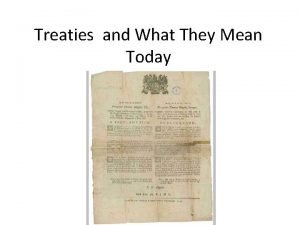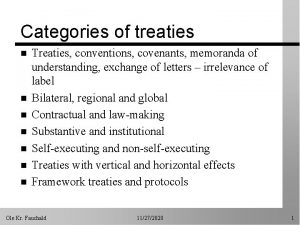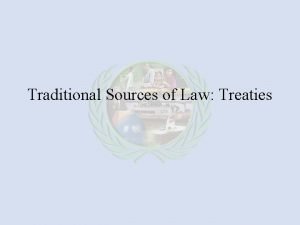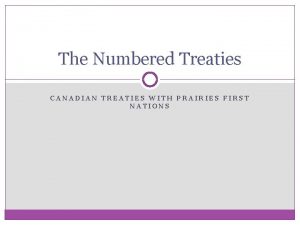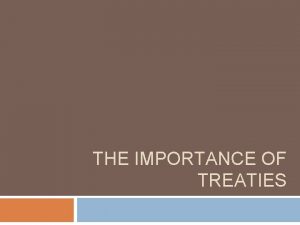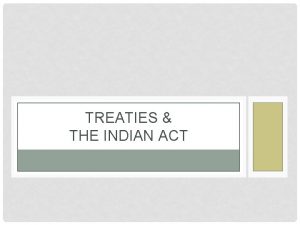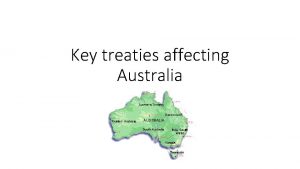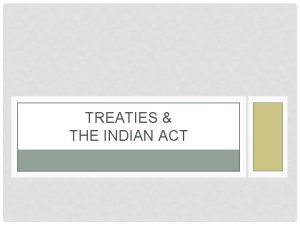Chapter 8 Alliances Treaties Covenants and Conventions Alliances

















































- Slides: 49

Chapter 8: Alliances, Treaties, Covenants and Conventions

Alliances �Alliance – a formal union or agreement to cooperate with other nations for a specific purpose or goal The North Atlantic Treaty Organization (NATO) North American Air Defense Agreement (NORAD) � Are two of the most important alliances Canada has joined.

Treaties � Treaty – is an agreement between states, international organizations, or both. Treaties take the form of conventions, covenants, and protocols (i. e. ICC Treaty, The Rome Statute) � Once signed by the states (countries), all treaties have the force of law among the signatories � Signatories also have the moral obligation to respect the treaty terms � Treaties must be ratified by each state’s parliament or equivalent legislative body before becoming law

Bilateral Treaties �Bilateral Treaties – are negotiated between a limited number of states, usually only two, establishing legal obligations and rights between those states only. i. e. 1996 Softwood Lumber Agreement between Canada and the U. S.

Multilateral Treaties �Multilateral Treaties – include several nations and establish rights and obligations between each nation and every other nation in the treaty i. e. International Criminal Court – Treaty, Rome Statute Non-Proliferation of Nuclear Weapons Treaty (1968)

Military Alliances and the Arms Race: The Cold War. . . Canada as a Middle Power and Peacemaker

The Arms Race �After WWII, the Soviet Union began installing pro-soviet governments in eastern European countries �The U. S. also increased its military presence to stabilize post-war Europe and maintain the “communist threat” https: //www. youtube. com/watch? v=w. Vqzi. NV 7 d. GY

The Cold War �The Soviet Union conducted its first test of an Atomic Bomb in 1949, which set off a competition for superior military power and nuclear weaponry �Both the Soviet Union and the U. S. amassed a growing nuclear stockpile in an effort to maintain a balance of power

MAD Strategy �Mutually Assured Destruction – helped to ensure that neither side launched a nuclear attack, since massive retaliation was almost certain �The consequences of these nuclear strikes would be devastating for both the Superpowers, their Allies, and the World �Deterrence Policy: a policy under which the possession of nuclear weapons is seen to discourage or prevent opponents from attacking

Canada and U. S. Relations �Canada was viewed as a Middle-Power and was too influential to ignore … the creation of NATO arose �Canada’s Department of External Affairs proposed an International Organization for collective security

North Atlantic Treaty Organization �Under the framework f Article 51 of UN Charter, it was Canada’s first peacetime Military Alliance and provoked controversy �Shift in Canadian Relations – once reliant on Britain for security, Canada was gaining stature in international affairs and becoming more aligned with the U. S.

NATO �Established a unified military command for the collective protection of North America and Western Europe from a possible Soviet attack and promised to reduce the cost of maintaining separate military forces �NATO’s primary goal was to establish lasting peace in Europe

NATO �Remains headquartered in Brussels, Belgium �Under NATO, an armed attack against one or more of the founding states would be seen as an attack against all: All member states would be expected to come to the defence

Conventions and Crisis How successful has the UN been at maintaining peace?

The Geneva Conventions: Humanitarian Law � 16 countries ratified the first Geneva Convention (the Geneva Convention for the Amelioration of the Condition of the Wounded in Armies in the field) �Conventions, occurred in 1864, 1906, 1929, 1949 �Purpose to deal with the changing technologies and styles of war and to define humane treatment of different groups during war time

Timeline of Geneva Conventions � 1864 I: Combatants wounded in the field � 1906 II: Combatants wounded at sea � 1929 III: Prisoners of War � 1949 IV: Civilians

Geneva Conventions �They attempt to limit the barbarity of war both for combatants and for vulnerable noncombatants, such as civilians, medical, and volunteer workers, and journalists �Those who violate the Geneva Conventions i. e. genocide, can be tried as war criminals by the International Criminal Court ICC, regardless of the crime the court cannot impose the death penalty

Cold War RECAP – The Causes � Soviet fear of US nuclear attack after Hiroshima (1945) � US refusal to share nuclear technology � US President Truman’s dislike of Soviet dictator Joseph Stalin � US fear of Soviet nuclear attack (after 1949) � Soviet rejection of Western capitalism and colonialism � Soviet military dominance of Eastern European satellite states � Soviet support of revolutionary communism around the world

Diplomacy, MAD, and the Deterrence Policy succeeded in containing Cold War conflicts for the most part, but some crisis brought the Superpowers to the brink of Nuclear War …. .

The Cuban Missile Crisis - 1962 �The Discovery by the U. S. of short and long range missile installations underway in Cuba in October, 1962, marked the closest the world has come to a nuclear confrontation with devastating consequences �The 13 -day crisis almost resulted in nuclear war

The Cuban Missile Crisis 1962 �Only the manipulation of events by John and Robert Kennedy and the wisdom of Nikita Khrushchev prevented the unthinkable �The event led to direct talks to reduce the size of the nuclear arsenals on both sides and signalled an era of detente whereby both sides attempted to understand the adversary more https: //www. youtube. com/watch? v=l 66 pa. Pz. H-BU

� Read Pgs. 279 – 281 and pgs. 286 -287 Summarize and state the Significance of: � The Warsaw Pact � North American Aerospace Defense Command (NORAD) � The Treaty on the Non-Proliferation of Nuclear Weapons � Comprehensive Nuclear Test Ban Treaty Due: Monday Jan. 18 /10

The UN and Canada’s Role in Keeping Peace

The Suez Crisis - 1956 � There was a violent realignment in the balance of power in the Middle East and a flare up in the Cold War � Egyptian President Gamal Abdel Nasser (1918 -70) introduced a one party system and socialist reforms, strongly asserted Egypt’s independence � He was also a leader of Arab nationalism and the non- aligned movement (“Third World” countries not apart of the West or East during the Cold War)

The Instigators: U. S. and Britain � In 1956 – the U. S. with the support of Britain withdrew the financial support it had promised Egypt for the construction of the Aswan High Dam � In response, Nasser nationalized the Suez Canal, which was owned by the Franco-British Suez Canal Company � Any ships using the canal would pay a toll to Egypt thus helping Egypt fund the Aswan Dam which was central to Egypt’s massive hydro-electricity and irrigation projects

The Importance of the Canal �The Suez Canal links the Mediterranean to the Red Sea and is a vital shipping route between the Middle East and Europe

Threats �Britain and France made threats, and President Nasser didn’t back down �He spoke out in support of the Palestinians and threatened Israel �Many thought that this was an act of Western arrogance … �So France, Britain, and Israel secretly plotted and then attacked Egypt to regain control of the canal on October 29, 1956

The Response �The Attack on Egypt fractured NATO relations �The United States condemned Britain and France also forcing British Prime Minister Anthony Eden to resign �In France the public strongly supported the attack on Egypt

Canada’s Response and Further Reactions �Canada would officially not support either Britain or France �The UN and Soviet Union also condemned the attack �The Soviet Union threatened to bomb London and Paris, but was too preoccupied with the Hungarian revolution �The S. U. provided Egypt, Iraq, and Syria with military and economic support

Would war break out between the world’s two military Superpowers as they vied for influence in the region?

The U. S. �The U. S. ’s Foreign Policy stated that: It would use force, if necessary, to stop the “communist threat” in the Middle East from spreading Britain U. S. France Egypt Soviet Union

Canadian Diplomats and the UN �Britain and France vetoed ceasefire resolutions made by the Security Council and General Assembly of the UN �A Special Assembly was called at the UN

Lester B Pearson

Lester B. Pearson �Canada’s Secretary of State for External Affairs, proposed a large multinational UN force be created and positioned between Egyptian and Israeli forces to supervise ceasefire compliance – known as the “Canadian Initiative”

�Tensions remained high until mid-November, when the UN Emergency Force (UNEF arrived in Egypt, with soldiers from more than 20 countries) �The United States pressured Britain and France to allow the UN action �By late December, Britain and France withdrew from Egypt and Israel in 1957

Lester B. Pearson �For his extraordinary diplomatic achievement Pearson was awarded the 1957 Nobel Peace Prize �The honour reflected well on Canada in the world and recognized it as a peacekeeping nation

Accomplishments of the UN UN Peacekeeping and Conflict Resolution �A ceasefire in place �Consent from the disputing parties to deployment of UNEF �An impartial, lightly armed force, permitted to shoot only in self-defence https: //www. youtube. com/watch? v=Uke. DOHb 0 scc

Taking a Stand �Read p. 291 -292 – Lester B. Pearson �Answer Questions �# 1, 2 /10 �Due Tuesday - January 19, 2015

Ch. 9: Canada’s International Roles and Foreign Aid

Foreign Aid � Aid is a vital part of Canada’s Foreign Policy � Contributes to global security and prosperity � Every year Canada distributes billions of dollars in international development assistance in the form of goods and services, human knowledge and skills, and financial contributions to developing countries � Some is used for short term humanitarian assistance and emergency relief (i. e. Natural disasters)

Canadian International Development Agency (CIDA) �Created in 1968 to plan and implement Canada’s foreign aid programs �Distributes 80% of Canada’s aid �Supports projects in more than 150 countries �The largest share goes to the poorest countries of Africa, Asia, Latin America, and the Caribbean

CIDA’s Objectives �To meet basic human needs by providing primary health care, basic education, family planning, nutrition, water, sanitation, and shelter �To promote gender equality by supporting program that foster the equality of women in sustainable development of their societies �To help developing countries and countries in transition build environmentally sound infrastructures

CIDA’s Objectives Cont’d �To promote democratic values, good governance, and respect for human rights �To promote economic development by supporting private-sector initiatives �To help developing countries protect their environments and address regional environmental concerns

Canada’s Withdrawal of Foreign Aid � Canada has at times reduced foreign aid to countries that have committed human rights violations � It has also redirected aid to organizations that promote democratic and human rights within a country � Still the policy has not been universally applied as Canada continues to provide aid to China in spite of human rights violations � Some argue that Canada places trading interests ahead of its commitment to human rights

Purpose of Foreign Aid �Is distributed to improve the quality of life for people in developing countries through Sustainable Development Programs �Sustainable Development – is a development strategy which aims to meet the needs of the present without compromising the ability of future generations to meet their needs

Sustainable Development �Meeting the needs of future generations depends on how well society balances its social, economic, and environmental needs today. �Economic decisions made at all levels – globally, nationally, and locally have environmental consequences for the future

Earth Summit (1972, Stockholm, Sweden) �The first Summit involved political leaders, environmentalists, and activists to establish 26 principles to deal with issues confronting the environment and outlined global responsibilities of countries and their citizens �This marked the beginning of the official global environmental movement �Participants pledged to hold Earth Summits every 10 years to reassess the environmental health of the planet

Kyoto Protocol � At the Rio Earth Summit, countries recognized the urgent need to reduce threat of global warming and climate change Kyoto Objectives: � Targets for the reduction of greenhouse gas emissions on a country-by-country basis � A greenhouse gas emissions trading program � Additional meetings to establish penalties for failing to meet targets and implement procedures

�Read pgs. 318 -321 Main Topics: �Sustainable Development �Earth Summits (Rio, Johannesburg) �Kyoto Protocol �Answer Questions # 2, 3, 4
 Peace and friendship treaties
Peace and friendship treaties Law treaty
Law treaty Treaty 1 territory
Treaty 1 territory What branch of the government makes treaties
What branch of the government makes treaties What branch of the government makes treaties
What branch of the government makes treaties Numbered treaties worksheet
Numbered treaties worksheet Treaties of velasco
Treaties of velasco D&c section 49
D&c section 49 Doctrine and covenants section 112
Doctrine and covenants section 112 Symonds ryder
Symonds ryder Doctrine and covenants
Doctrine and covenants Doctrine and covenants 21
Doctrine and covenants 21 Doctrine and covenants 130
Doctrine and covenants 130 Doctrine and covenants 76:24
Doctrine and covenants 76:24 La.ldschurch.org/online
La.ldschurch.org/online Elijah kirtland temple
Elijah kirtland temple Doctrine and covenants section 110
Doctrine and covenants section 110 Section 121 doctrine covenants
Section 121 doctrine covenants James covill lds
James covill lds Doctrine and covenants 121
Doctrine and covenants 121 Doctrine and covenants 1:30
Doctrine and covenants 1:30 Doctrine and covenants 163
Doctrine and covenants 163 Doctrine and covenants 69
Doctrine and covenants 69 Doctrine and covenants 20
Doctrine and covenants 20 Entry strategy and strategic alliances
Entry strategy and strategic alliances In terms of the build borrow or buy framework
In terms of the build borrow or buy framework Entry strategy and strategic alliances
Entry strategy and strategic alliances Strategy
Strategy Alliances and acquisitions
Alliances and acquisitions Kings of israel and judah chart
Kings of israel and judah chart 7 covenants of the bible
7 covenants of the bible Imperialism in 1900
Imperialism in 1900 Cost of world war 1
Cost of world war 1 Types of functional alliances
Types of functional alliances Doctrines et alliances
Doctrines et alliances Global strategic alliance definition
Global strategic alliance definition World war i combatants
World war i combatants The three world order
The three world order Angeliki dedopoulou
Angeliki dedopoulou Sap university alliances
Sap university alliances World war one alliances cartoon
World war one alliances cartoon Imperialism nationalism militarism alliances
Imperialism nationalism militarism alliances Designed alliances
Designed alliances Media codes and conventions
Media codes and conventions What codes and conventions were used in this movie poster
What codes and conventions were used in this movie poster Photography codes and conventions
Photography codes and conventions Technical codes audio
Technical codes audio What film is this
What film is this Documentary genre conventions
Documentary genre conventions Conventions of a news report
Conventions of a news report
